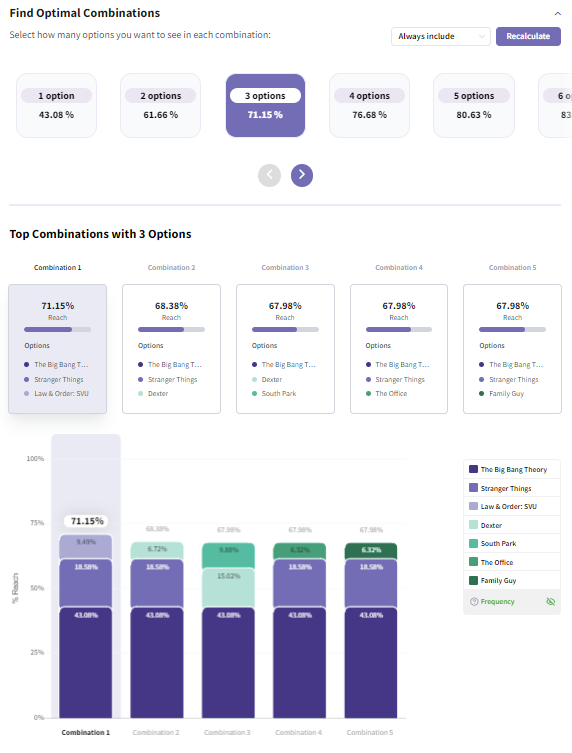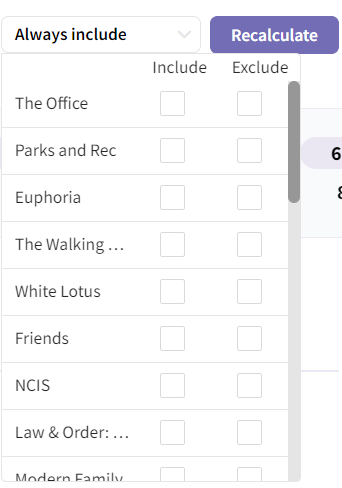Amidst the myriad of methodologies and tools available in market research, one approach stands out for its ability to provide unique and valuable insights: Total Unduplicated Reach and Frequency. Also known as TURF Analysis.
Today, we'll explore TURF analysis, digging into its intricacies, practical applications, and profound impact on business strategy and decision-making.
What is a TURF Analysis?
TURF analysis is a sophisticated statistical technique that analyzes the potential reach and frequency of various product combinations within a target market. It does this by analyzing tradeoff decisions and finding an optimal mix of products, product features, or messaging points that will appeal to the maximum number of people.
TURF is often used by businesses to estimate the market potential of a product, optimize product lines, and maximize the reach of an offering.
Components of a TURF Analysis
As mentioned above, TURF stands for Total Unduplicated Reach AND Frequency. Both factors play a unique role:
Reach (R)
The "reach" component focuses on identifying the distinct segments of the target market that are reached by each product or service. By analyzing the overlap and uniqueness of audience segments, businesses can better understand their market penetration and identify opportunities to expand their reach.
Frequency (F)
Frequency analysis delves into how often consumers choose (or use) a particular feature or product. By examining consumer behavior and usage patterns, businesses can identify the most popular and in-demand offerings and opportunities to enhance product relevance and appeal.
TURF Analysis Example
To bring this to life, let's consider a hypothetical scenario that illustrates TURF analysis in action:
Imagine you're a product manager for a beverage company. You've been tasked with optimizing the company's new line of flavored sparkling water. The Innovation team has already concocted five potential flavors, but only three will be brought to market. Your goal is to identify the right combination of flavors that maximize market reach and appeal to diverse consumers.
So, you turn to research.
Using the five flavors supplied by your innovation team, you design a survey that asks participants to choose their three preferred flavors from a list of options.
You analyze the results with a TURF analysis tool (like this one) to find the frequency of each flavor combination. Your output would look something like the graph below:

Right off the bat, you can choose the number of options for the final combination. Upon selecting "three," you will be given the top combinations with three options, each displaying its reach.
If you suddenly needed to exclude or always include one of your options, you could easily update your analysis to include this new condition. This means that changes in direction have a lesser impact on your research.

For the sake of our example, let's say the combination of Lemon, Lime, and Mango has the highest total unduplicated reach, reaching 65% of the market.
Based on this analysis, you recommend that your company launch the new sparkling water line with the Lemon, Lime, and Mango flavors, as it offers the highest potential reach and appeals to a broad audience.
Other Ways to Use TURF Analysis
While building and expanding product lines is a popular use case for TURF Analysis, there are many other times when brands use this approach, including:
TURF Analysis for Product Development
When developing a single new product, you can use a TURF analysis to optimize the product's features. This ensures you select the mix that appeals to the broadest audience.
TURF Analysis in Marketing & Advertising
When developing a new campaign, you can use TURF analysis to find the right mix of channels to optimize your audience reach. You can also find the most impactful combinations of copy or creative.
TURF Analysis for Competitive Intel
Interestingly, TURF analysis can also be used to evaluate competitors' offerings and identify areas of opportunity or differentiation. By comparing the reach and frequency of competing products or services within the market, you can gain valuable insights into their competitive position and identify strategies to capture market share.
SightX TURF Analysis Software
Historically, research and insights work was costly, time consuming, fragmented, and not widely shared.
So we decided to change that.
SightX is an AI-driven market research platform offering a single unified solution for product, brand, marketing, and pricing research. While powerful enough for insights teams at Fortune 500 companies, our user-friendly interface makes it simple for anyone to start, optimize, and scale their research.
With our new Generative AI consultant, Ada, you can harness the power of OpenAI's GPT to transform your marketing research and insights. Collaborating with Ada is like having an expert researcher, brilliant statistician, and ace marketer on your team, helping you ask the right questions, choose the best experiments, pick out key insights, and seamlessly apply them to your business.
